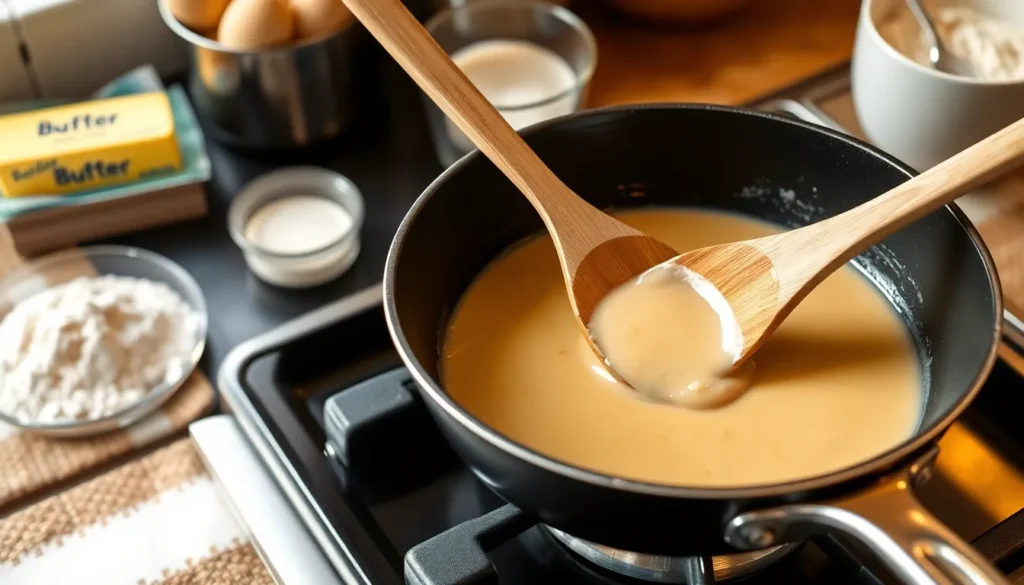Table of Contents
ToggleWhen it comes to cooking, mastering the art of roux can feel like trying to solve a culinary Rubik’s Cube. The secret? It all boils down to the butter-to-flour ratio. Get it right, and you’ll create a silky sauce that’ll make your taste buds dance. Get it wrong, and well, let’s just say your dish might end up looking like a science experiment gone wrong.
Understanding Roux
Roux serves as a foundational component in sauces and soups, acting as a thickening agent. The primary ingredients comprise equal parts butter and flour, which creates a balanced mixture important for consistency. In practice, a standard butter-to-flour ratio of 1:1 by weight works well for most applications. For example, using 2 tablespoons of butter pairs with 2 tablespoons of flour for a small batch.
Instruction dictates that cooks heat butter until melted, then add flour gradually. The mixture should cook on low heat, allowing the flour to sift evenly and absorb the fat without browning. The cooking time varies depending on the desired roux color—white, blond, or brown. White roux requires about 2 minutes, while darker varieties may take 5 to 15 minutes.
Consistency matters in achieving the desired sauce texture. Assessing the thickness is essential; a thicker roux suits gravies, while a thinner option benefits sauces like béchamel. Knowing which consistency suits the dish allows for greater culinary versatility.
Understanding how to adjust the butter-to-flour ratio enhances flavor and texture. For cream-based sauces, increasing the butter enhances richness, while adding more flour can prevent separation. Experimenting with variations fosters a deeper understanding of roux and its applications.
Overall, mastering the butter-to-flour ratio leads to successful roux, elevating dishes and enriching flavors. Recognizing the intricacies behind roux preparation sets the foundation for many delectable recipes.
Importance of Butter to Flour Ratio for Roux


A precise butter to flour ratio is crucial in creating a perfect roux. This balance directly influences the texture and flavor of sauces and soups.
The Role of Butter
Butter acts as a base for the roux. It provides a rich, creamy flavor that enhances the overall dish. The fat content in butter contributes to the silky texture of sauces. Additionally, the cooking process allows the water in butter to evaporate, enabling the flour to absorb fat and develop flavor. The right amount of butter ensures that the roux browns evenly, resulting in a deeper color and more complex taste. Properly measuring butter is essential for achieving the desired consistency, regardless of the type of roux being prepared.
The Role of Flour
Flour serves as the thickening agent in the roux. It contains starch, which gelatinizes when heated and thickens the mixture. This starch also helps bind the liquids in the sauce, creating a cohesive texture. The quantity of flour impacts how thick the final product becomes. Insufficient flour may lead to a soupy texture, while too much can yield a paste-like consistency. Choosing the right type of flour is important as well, with all-purpose flour being a common choice for versatility. The flour’s role in the roux is fundamental to achieving the desired thickness and stability in the finished dish.
Ideal Butter to Flour Ratio
Getting the butter-to-flour ratio right is crucial for achieving the perfect roux. This balance sets the stage for sauces and soups that boast the right texture and flavor.
Light Roux
A light roux typically uses equal parts butter and flour. This 1:1 ratio works best when making sauces like béchamel as it creates a smooth, creamy base. Cooking time remains short, around 2 to 3 minutes, allowing the flour to absorb the fat without browning. The goal here focuses on maintaining a pale color while producing a subtle flavor that won’t overpower the dish.
Medium Roux
For a medium roux, the same butter and flour ratio still applies, but cooking duration extends to 4 to 5 minutes. This method develops a slightly darker color and nuttier flavor, ideal for gravies and thicker sauces. The intensity of flavor increases, enhancing dishes like gumbo or a hearty cheese sauce. Acknowledging that the variation in heat alters the outcome is essential for achieving the desired taste.
Dark Roux
A dark roux requires the same amount of butter and flour once again. However, the cooking time can stretch to 10 to 20 minutes, depending on the desired depth. This technique provides a rich, robust flavor perfect for Cajun and Creole cuisines. Achieving a deep brown color demands attention, as the roux can burn easily. Understanding the timing and the importance of consistent stirring ensures a successful outcome with an aromatic base.
Tips for Achieving the Perfect Roux
Achieving a flawless roux requires careful attention to quality ingredients and proper cooking techniques. Focusing on these elements enhances flavor and consistency.
Choosing the Right Ingredients
Selecting high-quality ingredients plays a significant role in creating a successful roux. Unsalted butter allows for better control over the overall flavor. Choosing all-purpose flour typically provides the necessary starch content for thickening. Alternative flours, such as whole wheat or gluten-free options, can also be suitable, but they may alter the texture and flavor profile. Using fresh flour ensures optimal performance, while room temperature butter incorporates more easily. The balance between the two creates a smooth texture and rich flavor for various sauces.
Cooking Techniques
Mastering cooking techniques is essential for perfecting a roux. Heating the butter slowly allows it to melt evenly without burning. Once melted, adding flour gradually helps to prevent clumping. Continuous stirring maintains a uniform mixture and prevents sticking. For achieving the desired color and taste, adjusting cooking times is crucial. A light roux requires a quick 2 to 3 minutes of cooking, while a medium roux takes 4 to 5 minutes. Dark roux demands patience, with a cooking time of 10 to 20 minutes. Monitoring the heat ensures the roux develops flavor without burning.







